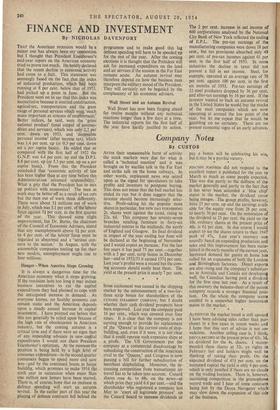FINANCE AND INVESTMENT
By NICHOLAS DAVENPORT THAT the American recession would be a Minor one has always been my contention but I thought that President Eisenhower's mid-year report on the American economy tried to prove too much. He boldly declared that the recent decline in economic activity had come to a halt. This statement was seemingly based on the fact that the index of industrial production, which had been running at 8 per cent. below that of 1953, had picked up a point in June. But the President went on to say that this index was inconclusive because it omitted construction, agriculture, transportation and the great range of personal services which were 'much more important as sources of employment.' Better indices, he said, were the 'gross national product' (total output of commo- dities and services), which was only 2.7 per cent. down on 1953, and 'disposable personal income' (after income tax), which was 1.4 per cent. up (or 0.3 per cont. down on a per capita basis). He added that as compared with the first half of 1952 the G.N.P. was 4.4 per cent. up and the D.P.I. 8.8 per cent. up (or 5.3 per cent. up on a per capita basis). From this the President concluded that 'economic activity of late has been higher than at any time before this Administration assumed responsibility.' What a pity that the President has to mix up politics with economics! The man at work may be better off as a result of tax cuts but the men out of work think differently. There were about 31 millions out of work in July, which was 5.1 per cent. of the labour force against 51 per cent. in the first quarter of the year. This showed some slight improvement, but Dr. Burns, the chairman of the Council of Economic Advisers, stated that any unemployment above 31 per cent. to 4 per cent. of the labour force must be regarded as abnormal and a 'serious con- cern to the nation.' In August, with the automobile companies tooling up for their new models, unemployment might rise to four millions.
Danger—When America Stops Crowing It is always a dangerous time for the American economy when it stops growing. If the recession lasts too long it may induce business executives to cut the capital expenditures they had planned to cope with the anticipated increase in demand. As everyone knows, no healthy economy can remain static and the American depends upon a steady annual increase in capital investment. I have pointed out before that this can generally be relied upon because of the high rate of obsolescence in American industry, but the coming autumn is a critical time and if there were no signs then of any impending advance in new capital expenditures I would not share President Eisenhower's optimism. At the moment the position is being held by a high level of consumer expenditure—in the second quarter consumers began to spend more and save less—and by the continued boom in house buildihg, which promises to make 1954 the sixth year in succession when more than one million new homes have been started. There is, of course, hope that an increase in defence .spending will start an autumn revival. In the earlier part of this year the placing of defence contracts fell behind the programme and to make good this lag defence spending will have to be speeded up for the rest of the year. After the coming elections it is thought that the President will ask for increased expenditure on the land and air services if the tension in the Far East remains acute. An autumn revival may therefore depend on how the business man interprets the military mood of the President. They will certainly not be beguiled by the complacency of his economic advisers.
Wall Street and an Autumn Revival Wall Street has now been forging ahead for twelve months without any technical reactions longer than a few days at a time. The industrial reports for the first half of the year have hardly justified its action. The 2 per cent. increase in net income of 660 corporations analysed by the National City Bank of New York reflected the ending of E.P.L. The pre-tax earnings of the manufacturing companies were down 18 per cent., but tax provisions absorbed only 49 per cent. of pre-tax incomes against 61 per cent. in the first half of 1953. In some industries the decline in taxes did not prevent a fall in net income. Steel, for example, operated at an average rate of 70 per cent. against 100 per cent. in the first six months of 1953, Pre-tax earnings of 32 steel producers dropped by 36 per cent. and after-tax earnings by 16 per cent. if the investor wanted to back an autumn revival in the United States he would buy the stocks of the steel companies which are now operating at around the low point of the year, but let me repeat that he would be gambling on no certainty. There are no present economic signs of an early advance.


































 Previous page
Previous page